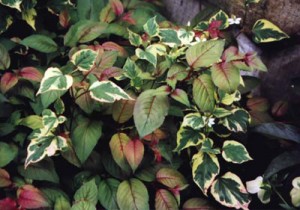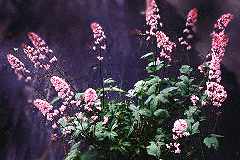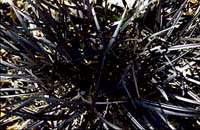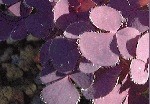Landscaping is like interior decorating. You calculate the space you Have, chose the colors, and work with light exposure to maximize comfort. In semi – shady spots, you can brighten it ups with brightly colored plants such as hardy fuchsias or lilies. What to do for accessories? For a beginning consider adding FOLIAGE like ferns, hostas or caladiums. All fill nicely between and there are many more!
Astrantia major ‘Ruby Wedding’ (I think!) is on its second summer with me. It is a lovely plant and just keeps on flowering. Highly recommended!
Polemonium caeruleum the variegated Jacob’s Ladder is one I used to grow. Like Fuchsias they prefer cooler climates, but with careful siting and well prepared soils, will thrive in warmer ones. This means giving it partial to full shade. Aside form the remarkable foliage, the plant presents violet-blue flowers from late spring into summer.
I want this plant! It’s an introduction from the renowned UK nursery, Blooms of Bressingham. I have, over the years, had assorted Jacob’s ladders come and go in my garden. I think that they have gone because I have allowed them to get too dry in our hot summers. They are also plants who actually prefer cooler climates, but who, with careful siting and decent attention, will thrive in warmer ones. This means giving it partial to full shade, especially in southern states, and rich, moist, well-drained soil. It’s rated hardy from USDA zones 4-8 This means my zone is about as far south as it is going to be really happy
Weedy relatives notwithstanding, the incredible foliage calls me, irresistibly, toward this plant. I read that one should simply cut off the rather nondescript pinkish to whitish flowers, which add nothing to the plant, so as to encourage new foliage growth and prevent seeding about, though seeding will be more probable in cooler than warmer climates.t does quite well in shade, becoming approximately twelve to eighteen inches (30.4 – 45.7 cm) tall, with leaves radiating out from the clump,, like a “wild looking hosta”. It prefers well-drained soil in the neutral pH range, in sun or part shade, but if anything like its cousins, will grow in a wide range of conditions.
Feeling Blue? Omphalodes ‘Parisian Skies’ looks like a prime candidate for a ‘first listing!’ for these early-blooming perennials, are best in part shade and tolerate dry shade. Like Hardy Fuchsias they will take full sun in cooler climates and prefer soil that don’t get dry out. USDA zones 6-9.
At the local flower show Corydalis. flexuosa ‘China Blue’ were being sold by a few vendors. ‘Blue Panda’ actually arrived on the gardening scene first grows eight to twelve inches tall and is not as vigorous as ‘China Blue.’ ‘The flowers, as you can see, are sky blue, lighter than ‘China Blue’s’. The foliage of ‘Blue Panda also has a bluish cast. There is a variegated form that is quite ugly.
Oh, I don’t care if the flexuosa species are a bit hard to please…I really have to have them. They tend to go dormant in summer and throw up a few leaves as the temperatures cool off in September, but that’s OK with me; many lovely spring plants hide away when the heat comes on. I simply have to devise a way of keeping things moist so that these guys don’t dry out, which is fatal to them, although they do not want a bog, either. Darker purple varieties are available as well. They make a perfect and dapper companion for the more torrid Fuchsia. The darker varieties look great with variegated grasses. More on that on the last page. Fuchsia mag. ‘Variegata’ caps the fuchsia list. Keep this in mind when I get to the grasses.
I’ve been toying with hardy fuchsias and Fuchsia magellanica ‘Variegata’ caps it. I have to have it. A hardy fuchsia with variegated foliage is more than I can stand. This is going to be an experiment, especially with this one, because it’s rated to zone 8. But, I’ve been chatting online about these and the consensus is that it’s worth a try if I can give it a protected spot in the shade and mulch well over winter. Plus, I will need to take a few cuttings in the fall as insurance and they are easy..
These plants really prefer cool weather and part shade, although In cooler gardens like the Pacific North West they do better in sun than shade. They form small shrubs each year and generally die back to the ground. Hummingbirds love them and I have long been attracted to the flower form. This is the year to get some and stop thinking and start planting.
The Diascias are often used in hanging baskets, but make great companions to the fuchia bed. Like the fuchsia they will bloom from summer until hard frost. Sometimes even into early winter. They have all but finished flowering now, so I brought the baskets that were hanging on the potting shed to the front of the house where they will enjoy the winter sunshine. Autumn also welcomes the arrival of Zauchneria californica – hard to find but totally suitable for well drained soils and thrive in Sequim
Interesting Trees!
The male plant carries torrents of creamy tassels which have a hint of dull-pink in their subtle, almost luminous, shadings. The display,nicely timed to accompany creamy-yellow jonquils, lemon-yellow primroses, bluebells and the other soft shades of early spring, begins in midwinter and ends with the coming of the warmer spring weather.
Nurseries don’t always sell good stuff!
Campanula rapunculoides, Polygonum cuspidatum, Houttuynia cordata, mints, and Aegopodium podagraria )Variegated Bishops wee) all fall into this category because they spread by underground roots. Inviting Houttynia into the garden was once described as comparable to inviting the Hells Angels into a Choir.
For the moister gardens. Polygonum’s and morel
COLOR ME PURPLE! Heuchera and Heucherella!
The shape and texture of the leaves is as important as the color. A good start for playing with shape design is toinsertcontrasting leaf shapes. For example, start with a ornamental grasse and then add a plant with a completely different form, such as one with rounded leaves. Here we have a gold Hosta, painted fern aome red grass, behind are hardy Begonia. The combinations are endless. I always suggest you bring in a leaf sample of your own when you go to the nursery and then experiment with combinations until something clicks.
Hosta, “Piedmont Gold” and maybe some columbines, that would put a touch of blue to contrast. For an efficient combination of simple leaf shapes, I like peony, columbine, and iris for example.
Variegated Hakonechloa, Japanese forest grass, If you don’t grow one of these plants, you’re missing a great garden.
Oxalis well tamed varieties-Oxalis arborescens,Oxalis tetraphylla ‘Iron Cross,’Oxalis riangularis. and the purple (oxalis magellenica.)
(C) 2004 edited 2014




















